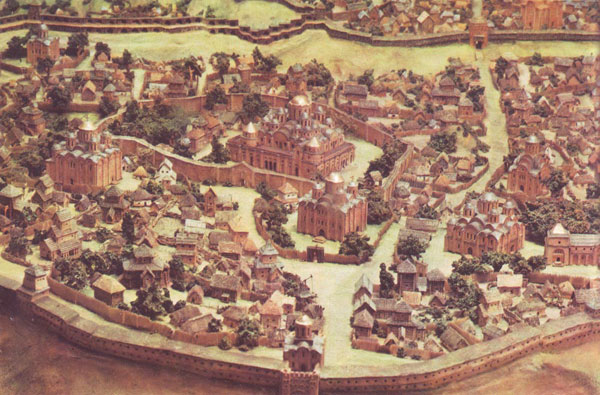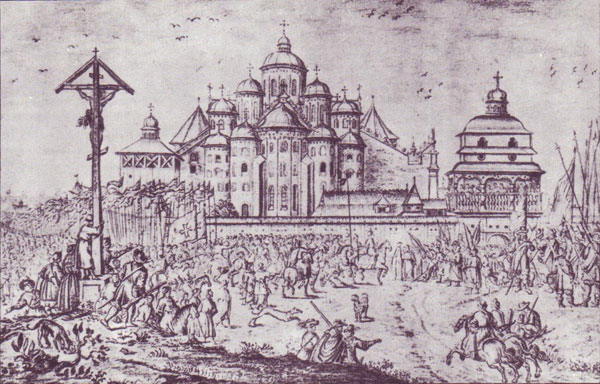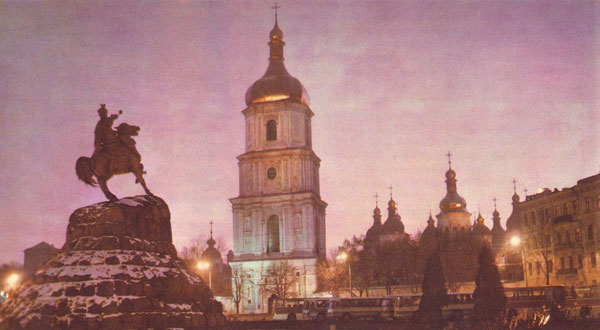ua. ru. en.
Museum ST. SOPHIA CATHEDRAL
Historical information
Plan of museum
ST. SOPHIA CATHEDRAL
Narthex
Architecture and murals
- Plan, Ground floor
- Mosaics
- Frescos
- Graffiti
- other details
Sarcophagus of Yaroslav the Wise
North cloister
Towers
Lofts
- Plan, First floor
ARCHITECTURAL MONUMENTS OF THE 18TH CENTURY
Bell Tower
Seminary
Cells of the Cathedral Elders
Metropolitan's Residence
Refectory
Consistory
South Entrance Tower
Zaborovsky Gate
First Rus library
BRANCHES OF THE MUSEUM
|
|
Excursions Kiev
weekend in Kiev
trip to Kiev
Excursions
tours to Kiev
Sights of Kiev
HISTORICAL INFORMATION of St. Sophia Cathedral
The St. Sophia Cathedral Museum is a state-preserved architectural and historical monument located in the centre of Kiev. This remarkably beautiful complex, representing 11th to 18th-century architecture, occupies five hectares (12 1/3 acres) of spacious grounds. Sofia Cathedral focus point is the grandly famed relic of 11th-century architecture and monumental art.
The Sophia Cathedral belongs to the most prosperous period of Kievan Rus, the mighty Eastern-Slavic state which was the cradle for three peoples - the Ukrainians, Russians, and Byelorussians.
Kievan Rus reached the acme in its economic and cultural development during the reign of Grand Prince Vladimir Svyatoslavich (978-1015) and his son, Prince Yaroslav the Wise (1019-1054).
In 988 A. D. Grand Prince Vladimir Svyatoslavich introduced Christianity into Rus, and this was of great import to the future development of feudal relationships, to the consolidation of a united Rus, to the promotion of a cultural upsurge and to the widening of political and cultural ties with Byzantium and other European states.
When Old Rus adopted Christianity, the building of brick churches began. The best builders and artists of the time were called upon to take part, and these made use of the highest art and technical achievements of the epoch. The murals and stone carvings that ornamented the churches turned the latter into unique works of art.
The major task of town construction was solved simultaneously with the building of brick churches. When the first brick church went up in the centre of Kiev - the Church of the Tithes (989-996 A.D.) - Grand Prince Vladimir Svyatoslavich made considerable extensions and fortifications to the town proper. His son, Prince Yaroslav the Wise, continued his father's traditions: the territory of the kremlin, or the main fortification, was increased eight-fold and surrounded by new defence ramparts. It was at this time that the metropolitan church was built - St. Sophia Cathedral, the principal monumental structure of the city
The building of Saint Sophia Cathedral in Kiev
According to chronicles the foundation of the Sofia Cathedral was laid in 1017 or 1037. St. Sophia Cathedral, the central structure of Yaroslav's town, was surrounded by brick churches, boyars' castles, and dwellings of the townsmen.
The grounds of the city were guarded by a brick wall. In our days, the only relics of the 11th century that have survived are the St. Sophia Cathedral and the ruins of the Golden Gates - the main entrance into ancient Kiev.
Ancient Kiev, 10th-13th cc. A scale model Detail The town of Yaroslav. Artist D. Mazyukevich:
The name of the cathedral, "Sophia", comes from the Greek word "sophia" which means "wisdom". Consecrated to the "wisdom of Christ's teaching", the cathedral would, according to its founder Yaroslav, firmly establish Christianity. As the main metropolitan church of Rus, St. Sophia Cathedral in those early times was the community and cultural centre of the state. It was here that the coronation ceremony was performed to anoint and crown the prince mounting the Grand Throne of Kiev; it was here that foreign ambassadors were received; here the Kiev veche (popular assembly) was held, before the St. Sophia Cathedral walls; here the chronicles were written, for Yaroslav the Wise established at St. Sofia Cathedral the first library and scriptorium in Kiev Rus, the first so far as we know.
As early as the 11th century, St. Sophia Cathedral was appraised as an outstanding masterprice of art. Hi Marion, the first Russian metropolitan and an eminent publicist of his time, wrote: "A church of wonder and glory, the envy of all the countries round, for such another cannot be found in the whole world from east to west."
With its age-long past, the Saint Sophia Cathedral has survived enemy raids, looting, partial destruction, repairs and reconstruction.
During the taking of the town by the hordes of Batu Khan in 1240, one of the gravest periods in the history of Old Rus, most of the city was ruined. But the Sofia Cathedral remained standing. However, looted and devastated, Sofievskiy Cathedral lost its former grandeur though it was still the main active church in town. Throughout the 14th and 15th centuries, the citizens of Kiev had to carry on a struggle against the Lithuanian and Polish feudal lords as well as against the Crimean Tartars who ravaged the town with robber raids. In 1416, Kiev was looted and burned by Edighei Khan and in 1482 by Menglis-Ghirei.
St. Sophia Cathedral. Drawing by A. van Westerveldt. 1651:
The yoke of the Polish feudal lords grew heavier in the 16th century. The occupation of the Ukrainian lands and the enforcements of the Roman Catholic faith upon the population resulted in the Ukraine's being included in 1596 into the Brest Uniate religious community whose aim was to unite the Orthodox and the Catholic Churches under the supremacy of the Pope in Rome. The Catholic Church and the Uniate began to eradicate the Orthodox. Taken over by the Uniates, Kiev's St. Sophia Cathedral fell into a complete decline. The roofing became dilapidated, the austere cloister arches were ruined and many murals destroyed.
However, in the thirties and forties of the 17th century, the Kiev Metropolitan Petr Mogila took St. Sofia Cathedral away from the Uniates and founded an Orthodox monastery as part of the church. At this time the Sofievskiy cathedral was partially repaired, wooden monastery buildings were added and the grounds were enclosed by a high wooden fence. Petr Mogila engaged the Italian architect Octaviano Mancini to carry out restoration work on the cathedral.
The 17th century is notable for the national liberation struggle waged by the Ukrainian people under the leadership of Bogdan Khmelnitsky, and for the resultant reunification of the Ukraine with Russia. The historical decision of the Pereyaslav Rada was confirmed in 1654 in St. Sophia Cathedral. The reunification evoked a great political and cultural upsurge in the Ukraine.
The 17th and 18th centuries witnessed intensive construction, using stone and brick.
The wooden buildings of the St. Sophia Monastery were destroyed by a great fire in 1697. Two years later, however, restoration of the cathedral was begun and new brick structures built around St. Sofia Cathedral by order of Peter the Great.
The new monastery complex was completed only by 1767. It was during these years that around St. Sophia Cathedral the bell tower was erected, the refectory, the bakery, the Metropolitan's residence, the West Gate (or Zaborovsky Gate) , the monastery's brick wall, the south entrance tower, the cells of the cathedral elders and the seminary. After reconstruction, the architectural style of the monastery buildings and the exterior of the St. Sofia Cathedral reflected features typical of the 17th- and 18th-century Ukrainian baroque. Partial changes were also made in the 19th century.
The result was the composition of a marvelous architectural complex.
St. Sofia Cathedral. View from Bogdan Khmelnitsky Square:
The Museum of St. Sophia Cathedral
In 1934 established the Museum of St. Sophia Cathedral as a special architectural and historical preserve to include the Sofievskiy Cathedral and the 18th-century monastery buildings.
The creation of this preserve opened a new page in the history of St. Sophia Cathedral. Wide opportunities were now made available for the research and restoration of the cathedral's architecture and mural relics. In this important work eminent Soviet artists, architects and scientists took part: I. Morgilevsky, M. Karger, N. Kresalny, Yu. Aseyev, V. Levitskaya, V. Lazarev, S. Vysotsky, L. Kalenichenko, Ye. Mamolat, to mention a few. A modern school of Ukrainian restorers and monumental artists grew out of the restoration of the St. Sophia frescos and mosaics.
The scientific research involved and the restoration work carried out. achieved notable results. The original architectural design of the St. Sofia Cathedral was reconstructed in model, hundreds of metres of wall space were cleaned to restore 11th- century frescos, fragments of old mosaic floors were brought to light, medieval graffiti were deciphered, remains of 11th-12th- century structures on the grounds were discovered, and repairs were made to 18th-century relics. The annual expenditures covering the costs of the work ran into large sums.
The establishment of the Museum of St. Sophia Cathedral has made this masterpiece of art available to the public. Its architecture and wall paintings provide aesthetic and patriotic education for the people and awaken respect and esteem for their homeland's treasures in culture and the arts. For a long time only St. Sophia Cathedral was on show in the Museum grounds. But at present work is going forward on preparing an exposition of the 18th-century architectural monuments.
And yet, Kiev's St. Sophia Cathedral remains the most important exhibit for sightseeing. It attracts an endless flow of excursion groups from all Urkaine and from many countries abroad. There are over a million visitors annually visit St. Sofia Cathedral in Kiev, all anxious to view this beautiful gem of world culture.
Enter the grounds of the Museum of St. Sophia Cathedral through the main gateway under the bell tower , and start your tour by going through St. Sophia Cathedral ending up with the interesting memorials of the 18th century.
St. Sofia Cathedral - View of the cathedral from the south-east:
Read more:
- Plan of museum
- ST. SOPHIA CATHEDRAL
- Mosaics
- Frescos
- other details
- ARCHITECTURAL MONUMENTS OF THE 18TH CENTURY at the territory of museum
Tegs: Saint Sophia Cathedral in Kiev was built, the construction of St. Sofia Cathedral in Kiev, the history of St. Sophia Cathedral Sofievskiy Museum
 Mosaics and frescoes of St. Sophia Cathedral IN KIEV
Mosaics and frescoes of St. Sophia Cathedral IN KIEV
Virtual tour around the museum’s grounds of Saint Sophia Cathedral
National Historical Reserve "St. Sophia Cathedral in Kiev"
Address: Vladimirskaya Str. 24, Kiev Ukraine
Underground station "Golden Gate".
Hours: 10:00 - 17.30
Closed: Thursday



